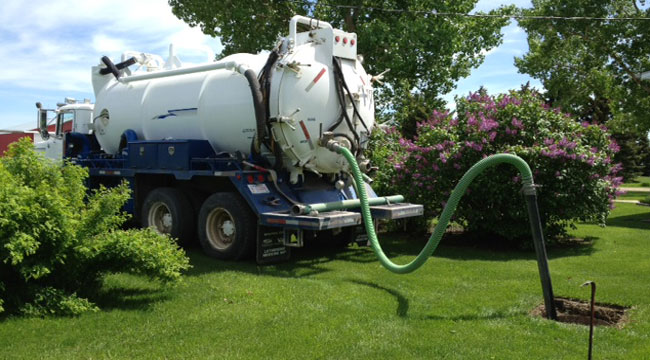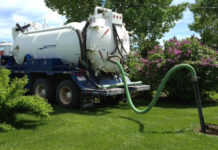Ballpark estimate: $300 to $500
Having a septic tank pumped is probably one of the last things any homeowner wants to think about. But ignoring this important maintenance step can lead to unsanitary back-ups into your home and potentially costly repairs to the septic system itself, so it’s important to have it done on a regular basis.
Septic System Logistics
If you live in a rural area or just don’t have access to a municipal sewer system, your home probably uses a standard septic system to dispose of the water and waste from toilets, sinks, showers, washers, and drains. These systems are generally installed when the house is built, but if your house is very old, the septic system has probably been upgraded sometime during in the past 20 to 30 years.
Septic systems are usually composed of three simple components. The septic tank itself is divided into two sections, the sediment tank and the water holding tank. Waste flows first into the sediment tank where the solids settle to the bottom and are broken down into sludge by naturally occurring bacteria. Water stays above the sediment, while oil and grease float to the top of the water. The water flows out of the sediment tank into the holding tank through a baffle that is below the floating scum and above the sediment. From the holding tank, water is directed to a series of pipes into the leaching field where it dissipates into the soil.
Since the water flow occurs between the floating scum and settled solids, it is important that neither of these layers becomes thick enough to impede the flow of the water. If this happens, a clog is likely and the result is a messy backup into the house, which can cause both inconvenience and potentially damage interior living space. Most contractors recommend pumping every 2 to 3 years to avoid this problem; however, if you have an unusual number of people living in your house you might consider more frequent pumping.
Hiring a Contractor
While it might technically possible to pump your own septic tank, it is not recommended. Large trucks with powerful pumps are required and special permits are needed to dispose of the waste. Look for a pumping contractor that has a good local reputation. Most pumping contractors also install and repair septic systems, so this is a good choice since you will want your system inspected at the same time you have it pumped. Two simple measurements should tell your contractor if your system is working correctly: the depth of the sediment and thickness of the scum. Neither should be closer than 3 to 5 inches from the effluent (output) pipe.
One way to help you choose a good pumping contractor is to look for members of the better business bureau (BBB) and be sure to check the BBB website to see if there are any complaints against a contractor before hiring. Another option is to ask family, friends, or neighbors about their experience with local pumping contractors. Or, do a search online or refer to online resources such as Angie’s List to find local contractors in your area who come recommended by other homeowners.
Contractors should be registered or licensed by your local board of health and should be properly disposing of the waste. (Feel free to ask the contractor where he/she disposes of waste just to be sure.) Many municipal sewage treatment plants will accept waste from contractors for a fee. If you have any concerns about the integrity of the contractor, call your local board of health and ask about any recent violations.
Cost of Septic Tank Pumping
Most of the cost for the pumping depends on the amount of sludge, effluent and scum the contractor needs to remove. Most contractors will include a free inspection of the tank and system to avoid future problems. The contractor may measure the depth of scum floating on the top and sludge sitting on the bottom of the tank, or simply estimate based on experience. As long as the system is working properly, the process should be fairly simple and should be complete in well under an hour.
Most contractors have a minimum charge for showing up that ranges between $125 to $250 depending on labor costs as well as supply and demand in your area. In addition, you will be charged per gallon of effluent pumped (the truck has a gauge that is subject to inspection by local authorities). For a typical family of four who is diligent about pumping every 3 years, the total cost will probably run about $300 to $350. If you have a large house with five to seven people living at home, expect to pay up to $500, especially if you have skipped an extra year or two (not recommended) between pumpings. Finally, costs may increase if the tank lid is in a difficult-to-reach spot, but this is relatively rare because the contractor will have hoses with long extensions and most systems are designed to be accessible.
A Cost-Saving Approach
If you would like to save a little money, you can dig down to the cover of the septic tank yourself. This is short work and probably won’t be worth your while, but it can save $25 to $50 depending on the contractor. Just ne sure to check with the contractor first to see if they will actually give you a discount for digging yourself. If you don’t know the location of your septic system, it might be best to let the contractor handle the entire job or you could end up digging several holes before you find the cover to the tank. Do not remove the cover yourself, as it is heavy and creates a drowning hazard for children, pets, and even adults.
A Final Note
The good news is that septic systems are surprisingly simple and reliable if pumped every 2 to 3 years as recommended by the experts. You can avoid expensive repairs by following this schedule. Otherwise, scum and sludge may build up more than normal, causing the leaching field to become clogged. This is a situation you want to avoid, since repairs to this part of the system are costly and may require digging up your entire yard.















































